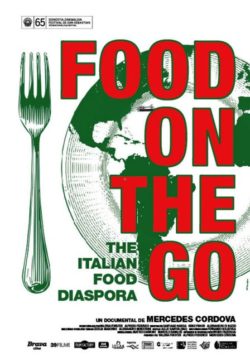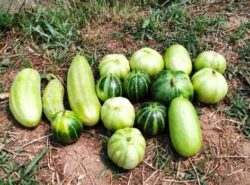Home » Browse » Ingredients » Ingredients: Italian Cucumber Dynasty In England
July 29, 2025 - Written by: Nancy PollardRead Time: 5 Minutes Subscribe & Share
A Cucumber Dynasty in England
 Much has been written about the Italian diaspora, particularly during the massive waves of emigration in the late 19th and early 20th centuries. In a previous Kitchen Detail post, I explored this subject through the noteworthy documentary Food on the Go, which focuses on Italian immigration in South America—especially Argentina. There, Italian communities largely resisted assimilation, holding tightly to their regional customs, dialects, and, of course, foodways. A historian based in Rome even runs a fascinating YouTube channel with excellent videos exploring these cultural threads across continents.
Much has been written about the Italian diaspora, particularly during the massive waves of emigration in the late 19th and early 20th centuries. In a previous Kitchen Detail post, I explored this subject through the noteworthy documentary Food on the Go, which focuses on Italian immigration in South America—especially Argentina. There, Italian communities largely resisted assimilation, holding tightly to their regional customs, dialects, and, of course, foodways. A historian based in Rome even runs a fascinating YouTube channel with excellent videos exploring these cultural threads across continents.
Meanwhile, my London-based daughter—who was also the first to alert me to the criminal conspiracy known as the Chorleywood Bread Process—recently tipped me off to a little-known tale of agricultural enterprise: the Sicilian cucumber dynasty in the UK. And since it is cucumber season (and this humble, underreported vegetable deserves more respect), I thought it worth shining a KD light on England’s cucumber underground.
England’s Salad Basket
While the British Isles are rarely associated with vegetable virtuosity, there is a surprising exception: the Lea Valley in Hertfordshire. Just an hour and a half’s drive from London, this stretch of fertile land along the River Lea has been a hotbed of market gardening since the 19th century. It even earned the nickname “England’s Salad Basket.”
Hertfordshire. Just an hour and a half’s drive from London, this stretch of fertile land along the River Lea has been a hotbed of market gardening since the 19th century. It even earned the nickname “England’s Salad Basket.”
Incidentally, the word “hotbed”—now used for all sorts of activity, not just horticultural—originated in gardening. A true hotbed was soil heated by fermenting manure, used to give seedlings a jumpstart in chilly climates. And it was precisely this kind of agricultural intensity that once defined the Lea Valley.
Historically, market gardens like those in Lea Valley fed major urban centers through waterways and early rail systems. But, as is the case in many once-rural outskirts, the greenhouses and plots have been increasingly threatened by urban sprawl. Today, much of the land — but thankfully not all hope — has been lost.
Some London restaurants, notably Ottolenghi’s, are helping revitalize the valley’s remaining garden plots and greenhouses through partnerships with a farming cooperative called OrganicLea. Growers from OrganicLea work directly with restaurants, schools, and community centers to plant and harvest according to their clients’ needs. Some restaurants rent plots and have specific crops grown to order—everything from exotic herbs to hard-to-source vegetables. Ottolenghi’s group, for instance, aims to eventually source all of its tomatoes, broad beans, climbing French beans, and Tromboncino courgettes from the cooperative.
The Sicilian Cucumber Connection
But let us return to the matter of Sicilian cucumber-raising families.
By the 1930s, after the repeal of the longstanding British glass tax, the Lea Valley boasted the highest concentration of greenhouses in the UK. But following World War II, the area faced a severe labor shortage. To address this, the British government introduced a special visa program for foreign workers willing to work in the Salad Basket’s greenhouses—which, at their peak, spanned over 1,300 hectares (today they cover less than 300).
 In an ironic twist, some of the earliest Italian workers in the greenhouses had originally arrived as prisoners of war. During the North African campaigns of WWII, captured Axis soldiers—both German and Italian—were held in the UK and assigned agricultural labor. One of the prison camps was located in the Lea Valley. After Italy signed a peace treaty with the Allies in 1943, conditions improved for the Italian POWs. Some were even allowed to move into the very farms where they had been forced to work. When the post-war visa program launched, many stayed on, becoming the first seeds—so to speak—of what would become a flourishing Italian agricultural enclave.
In an ironic twist, some of the earliest Italian workers in the greenhouses had originally arrived as prisoners of war. During the North African campaigns of WWII, captured Axis soldiers—both German and Italian—were held in the UK and assigned agricultural labor. One of the prison camps was located in the Lea Valley. After Italy signed a peace treaty with the Allies in 1943, conditions improved for the Italian POWs. Some were even allowed to move into the very farms where they had been forced to work. When the post-war visa program launched, many stayed on, becoming the first seeds—so to speak—of what would become a flourishing Italian agricultural enclave.
Many of these immigrant workers hailed from just two Sicilian villages: Cianciana and Mussomeli, both of which had been hit hard economically. Cianciana had been a sulfur mining town, and both villages had deep traditions of small-scale farming. Commercial gardening, then, wasn’t a leap for these families—it was a natural evolution.
Their descendants are still in the business today. In fact, many of the cucumbers you see in British supermarkets come from growers bearing familiar Sicilian surnames: Caffarelli, Pullara, Cannatella, Colletti. A few generations on, these families continue to cultivate fruit and vegetables, often expanding into wholesale markets and broader supply chains.
But Why Cucumbers?
It turns out that Italians have been serious about cucumbers since Roman times. Though cucumbers don’t have the culinary stardom of eggplant or zucchini, they’re embedded in regional traditions and come in many forms. The Carosello is perhaps the best known—technically a cucumber-melon hybrid, it comes in various shapes with striking stripes and a juicy, refreshing flesh. The Barattiere is round, sweet, and often preferred for its digestibility over the standard long green variety. And the pale green Tortarello, while technically more melon than cucumber, is eaten like the latter and can grow in whimsical serpentine shapes over a foot long.There’s even the San Donà gherkin—a specialty variety grown for tiny pickles, though far less photogenic than its flamboyant cousins.
refreshing flesh. The Barattiere is round, sweet, and often preferred for its digestibility over the standard long green variety. And the pale green Tortarello, while technically more melon than cucumber, is eaten like the latter and can grow in whimsical serpentine shapes over a foot long.There’s even the San Donà gherkin—a specialty variety grown for tiny pickles, though far less photogenic than its flamboyant cousins.
I must say that a diced cucumber instead of celery makes a delicious difference in the Lobster Roll recipe that I “borrowed” from Jasper White – this version is superior to any that I tried when visiting my sister-in-law in Maine. And at Christmas, I used to make a salad of paper thin slices of cucumer and white onion mixed in a dressing of champagne vinegar, dill, and sour cream. Cucumbers are required in my take on Greek Salad (I now add sliced braised artichoke hearts instead of raw green peppers). I would love to hear from KD readers how you feature cucumbers in your recipes – so do send them to me in the comment section below!

Kitchen Detail shares under the radar recipes, explores the art of cooking, the stories behind food, and the tools that bring it all together, while uncovering the social, political, and environmental truths that shape our culinary world.




I don’t know if I have any great recipes where I use cucumbers. I love just eating them in salads, by themselves dipped in some dressing, or mixed with tomatoes. I’d rather have salad without greens and just all the other good stuff including cucumbers. I detest the summer weather but I’m here for the produce.
Jennifer,
I am so with you on the summer weather. I would rather be in winter (warmly dressed, of course) but then other than citrus, there is something daunting about dense root vegetables for salads.
Nancy